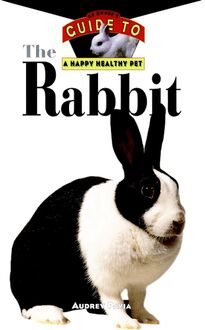-
 Univers
Univers
-
 Ebooks
Ebooks
-
 Livres audio
Livres audio
-
 Presse
Presse
-
 Podcasts
Podcasts
-
 BD
BD
-
 Documents
Documents
-
- Cours
- Révisions
- Ressources pédagogiques
- Sciences de l’éducation
- Manuels scolaires
- Langues
- Travaux de classe
- Annales de BEP
- Etudes supérieures
- Maternelle et primaire
- Fiches de lecture
- Orientation scolaire
- Méthodologie
- Corrigés de devoir
- Annales d’examens et concours
- Annales du bac
- Annales du brevet
- Rapports de stage
La lecture à portée de main
Vous pourrez modifier la taille du texte de cet ouvrage
Découvre YouScribe en t'inscrivant gratuitement
Je m'inscrisDécouvre YouScribe en t'inscrivant gratuitement
Je m'inscrisEn savoir plus
Vous pourrez modifier la taille du texte de cet ouvrage
En savoir plus

Description
These guides feature:
- Expert authors, plus renowned guest contributors on specialized topics
- Full-color photos throughout
- Basic information on the breed, species, or topic
- Complete coverage of care, health, grooming, training, and more
- Tips and techniques to make life with a pet more rewarding
PART ONE: Welcome to the World of Your Kitten.
1. The Kitten's Ancestry.
2. The Physical Kitten.
3. Indoor/Outdoor Concerns.
PART TWO: Living with Your Kitten.
4. Bringing Your Kitten Home Feeding Your Kitten.
6. Grooming Your Kitten.
7. Keeping Your Kitten Healthy.
PART THREE: Enjoying Your Kitten.
8. Play and Learning.
9. Basic Training.
10. Acting Up.
11. Introducing Your Kitten to Strangers.
PART FOUR: Beyond the Basics.
12. Recommended Reading.
13. Resources.
Sujets
Informations
| Publié par | Turner Publishing Company |
| Date de parution | 05 mai 2008 |
| Nombre de lectures | 0 |
| EAN13 | 9780470368961 |
| Langue | English |
| Poids de l'ouvrage | 3 Mo |
Informations légales : prix de location à la page 0,0898€. Cette information est donnée uniquement à titre indicatif conformément à la législation en vigueur.
Extrait
Kitten Care Training
Copyright 1996, 2001 by Wiley Publishing, Inc. All rights reserved
Howell Book House
Published by Wiley Publishing, Inc., Hoboken, NJ Published simultaneously in Canada
No part of this publication may be reproduced, stored in a retrieval system, or transmitted in any form or by any means, electronic, mechanical, photocopying, recording, scanning, or otherwise, except as permitted under Section 107 or 108 of the 1976 United States Copyright Act, without either the prior written permission of the Publisher, or authorization through payment of the appropriate per-copy fee to the Copyright Clearance Center, 222 Rosewood Drive, Danvers, MA 01923, (978) 750-8400, fax (978) 646-8600, or on the web at www.copyright.com . Requests to the Publisher for permission should be addressed to the Legal Department, Wiley Publishing, Inc., 10475 Crosspoint Blvd., Indianapolis, IN 46256, (317) 572-3447, fax (317) 572-4447.
Limit of Liability/Disclaimer of Warranty: While the publisher and the author have used their best efforts in preparing this book, they make no representations or warranties with respect to the accuracy or completeness of the contents of this book and specifically disclaim any implied warranties of merchantability or fitness for a particular purpose. No warranty may be created or extended by sales representatives or written sales materials. The advice and strategies contained herein may not be suitable for your situation. You should consult with a professional where appropriate. Neither the publisher nor the author shall be liable for any loss of profit or any other commercial damages, including but not limited to special, incidental, consequential, or other damages.
For general information about our other products and services, please contact our Customer Care Department within the United States at (800) 762-2974, outside the United States at (317) 572-3993 or fax (317) 572-4002.
Library of Congress Cataloging-in-Publication data Shojai, Amy. 1956-
Kitten care and training: an owner s guide to a happy healthy pet/by Amy Shojai.
p. cm.
Includes bibliographical references.
ISBN 0-87605-392-4
1. Kittens. 2. Cats. I. Title.
SF447.S48 S48 1996, 2001
636.8 07-dc20 95-49504
CIP
Manufactured in the United States of America
20 19 18 17 16 15 14 13 12
Second Edition
Series Director: Kira Sexton Book Design: Michele Laseau Cover Design: Michael Freeland Photography Editor: Richard Fox Photography:
Front and back cover photos by Ron Kimball Studio
Paulette Braun/Pets by Paulette: 4, 15, 75, 93, 146
Joan Balzarini: 17, 21, 27, 49, 77, 78, 80, 82, 113, 125, 127
Mary Bloom: 41
Cheryl Primeau: 5, 29, 35, 38-39, 61, 62, 76, 103, 104, 115, 130, 139, 142
Susan Rezy: 42, 43, 53, 58, 118, 121
Judith Strom: 64, 108, 110, 141
Jean Wentworth: 2-3, 6, 7, 9, 11, 18, 23, 26, 32, 34, 36, 40, 45, 46, 54, 65,
66, 68, 70, 91, 100-101, 102, 105, 106, 111, 128, 135, 136, 137, 140, 144
Page creation by: Wiley Indianapolis Composition Services
Contents
part one
Welcome to the World of Your Kitten
1 The Kitten s Ancestry
2 The Physical Kitten
3 Indoor/Outdoor Concerns
part two
Living with Your Kitten
4 Bringing Your Kitten Home
5 Feeding Your Kitten
6 Grooming Your Kitten
7 Keeping Your Kitten Healthy
part three
Enjoying Your Kitten
8 Play and Learning
9 Basic Training
10 Acting Up
11 Introducing Your Kitten to Strangers
part four
Beyond the Basics
12 Recommended Reading
13 Resources
part one
chapter 1
The Kitten?s Ancestry
Congratulations on the new arrival! Nothing prompts bigger smiles or greater delight than welcoming a fuzzy new baby into the family. Your kitten s batting paws, playful pounces, and insistent mews are not only endearing; they also reflect an aristocratic heritage. Cats purred their way into human hearts many thousands of years ago, and they have been enriching our lives ever since.
In the Beginning
Cats got their start long before humans were on the scene. Miacids , the earliest forebear of modern cats, evolved during the mid-Paleocene epoch about 61 million years ago. The earliest Miacids were small but ferocious carnivores that lived in forests and probably looked something like today s shrews. Experts believe they were equally at home on the ground or climbing trees, and they probably had retractable claws, like modern kitties.
A variety of catlike creatures sprang from the pint-size Miacids and flourished across most of the world. Miacids became the founding father for all modern carnivores, including the bear ( Ursidae ), weasel and badger ( Mustelidae ), hyena ( Hyaenidae ), civet, genet and mongoose ( Viverridae ), raccoon ( Procyonidae ), dog, fox and wolf ( Canidae ) and, of course, the entire cat family ( Felidae ).
The Felidae family tree is approximately three million years old .
But cats didn t start looking much like cats until about 12 million years ago when creatures resembling today s felines first prowled and growled across the world. Nine million years later, the Felidae family tree branched into the major cat types we currently recognize, and all modern-day cats, both big and small, evolved from these first felines.
Panthera are the big roaring cats: the lions, tigers, leopards and jaguars. Two big cats are so unique they have their own genus: Acinonyx for the cheetah and Neofelis for the clouded leopard. Felis embraces more than twenty-eight kinds of small cats, including cougars, bobcats, twenty-three subspecies of wildcats, and domestic cats like your kitten.
Cat Meets Human
Cats of all sizes were already on the scene when humans first appeared. In the beginning, people probably competed with cats for food, and no doubt they sometimes even stalked each other. Early man envied the feline s success, and he celebrated her hunting prowess in prehistoric cave drawings of lions. Cat amulets indicate that feline cults glorified the cat in Egypt as early as the 6th Dynasty.
Exactly when cats stepped over the threshold and became domesticated is still open to debate. Some experts believe domestication may have begun as early as 8,000 years ago. They point to a cat s jawbone dated 6000 B.C. discovered at an excavation site in southern Cyprus in 1983. Because this Mediterranean island has no native wild cats, it s believed the ancient kitty was brought there by human settlers.
D OMESTICATION
It s more generally accepted that cats were domesticated between 3,500 and 4,500 years ago in ancient Egypt. The first historical documents mentioning cats date from Egypt in 1668 B.C. , and paintings of cats with collars tethered to chairs in homes are found in Theban tombs dating from about 1450 B.C.
More than likely, kitty domesticated herself because the arrangement was mutually beneficial. When humans turned from hunting game to cultivating crops, the harvest was a magnet to voracious vermin. The scurrying rodents that pilfered grain stores in turn drew wild cats to the feast. Humans soon learned that cats helped protect crops and food stores from the rodents, and so they encouraged the cats to stay.
The direct ancestry of the domestic house cat has long been argued. Today, most experts agree that the grand-daddy of all house cats is the African Wildcat, Felis silvestris lybica . Slightly bigger than modern house cats, this big yellow tabby roams the deserts of Africa, Syria, Egypt and parts of India, and matches the mummified remains of the domesticated cats of ancient Egypt.
Cats came to us to prey on the vermin that stored crops attracted .
The Glory Days
Cats became major symbols of power and virility in ancient Egypt, and were much admired for their mystical qualities. Some civilizations invented glorious superhuman beings that combined human and feline characteristics, like the famous lion-man figure of the Sphinx at Giza, found outside Cairo, Egypt.
Affection for cats reached its zenith when kitty was literally put on a pedestal. About 950 B.C. , a city of the Nile delta called Bubastis worshiped a cat-headed goddess called Bast, or Pasht. She was the favorite of the sun-god, Ra, and was associated with happiness, pleasure, dancing and the warmth of the sun.
The smaller wildcats may have been brought into the temples to serve as surrogate deities because their size made them more manageable than lions or other big cats. Every move of the sacred temple cats was interpreted by the priests as a message from the goddess Bast.
BLACK CATS
Throughout time, black cats have been both praised as being bearers of great luck and persecuted as harbingers of grave misfortune. The word felis is Roman for a good and auspicious omen, though the Romans also called cats gatta , meaning weasel.
In the Middle Ages, black cats were associated with sorcery, and many were killed in symbolic ceremonies.
Black cats are linked to fate in many countries. In America it s said that if a black cat crosses your path it s bad luck; in Ireland it foretells death in an epidemic; yet in England and Asia, it means you will have great luck.
Black cats were kept by sailors wives to ensure their husbands safety, and have starred in stories and poems by Edgar Allan Poe and William Butler Yeats. More recently, they have been pets to such celebrities as Jimmy Connors and Donna Mills.
Grace and Beauty
Feline grace was considered the epitome of beauty. The eyes of the African Wildcat are rimmed with a dark lining, and fine Egyptian ladies used cosmetics to outline their own eyes not only as protection from the sun, but perhaps to mimic the look of these cats. Egyptian law protected cats, and each one s death was greatly mourned. Cats were a jealously guarded treasure not allowed to leave the country. But some were stolen and smuggled out by covetous visitors. Kitty traveled from Egypt and was soon introduced around the world.
Out of Egypt
Cats first traveled from Egypt to India, and from there to China and Japan. Alt
-
 Univers
Univers
-
 Ebooks
Ebooks
-
 Livres audio
Livres audio
-
 Presse
Presse
-
 Podcasts
Podcasts
-
 BD
BD
-
 Documents
Documents
-
Jeunesse
-
Littérature
-
Ressources professionnelles
-
Santé et bien-être
-
Savoirs
-
Education
-
Loisirs et hobbies
-
Art, musique et cinéma
-
Actualité et débat de société
-
Jeunesse
-
Littérature
-
Ressources professionnelles
-
Santé et bien-être
-
Savoirs
-
Education
-
Loisirs et hobbies
-
Art, musique et cinéma
-
Actualité et débat de société
-
Actualités
-
Lifestyle
-
Presse jeunesse
-
Presse professionnelle
-
Pratique
-
Presse sportive
-
Presse internationale
-
Culture & Médias
-
Action et Aventures
-
Science-fiction et Fantasy
-
Société
-
Jeunesse
-
Littérature
-
Ressources professionnelles
-
Santé et bien-être
-
Savoirs
-
Education
-
Loisirs et hobbies
-
Art, musique et cinéma
-
Actualité et débat de société
- Cours
- Révisions
- Ressources pédagogiques
- Sciences de l’éducation
- Manuels scolaires
- Langues
- Travaux de classe
- Annales de BEP
- Etudes supérieures
- Maternelle et primaire
- Fiches de lecture
- Orientation scolaire
- Méthodologie
- Corrigés de devoir
- Annales d’examens et concours
- Annales du bac
- Annales du brevet
- Rapports de stage




















